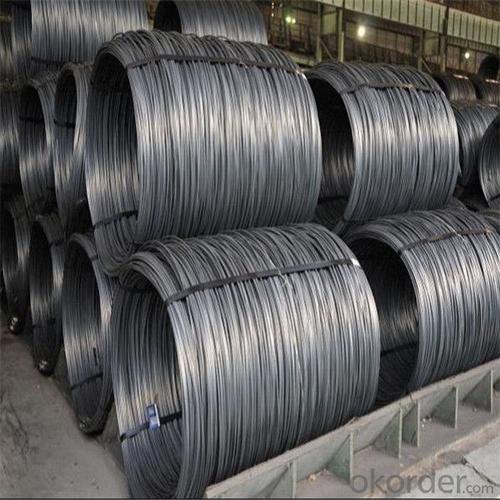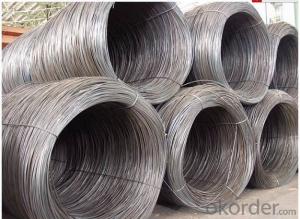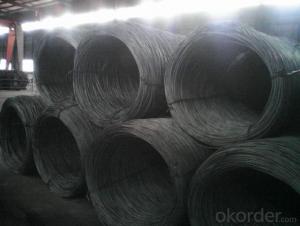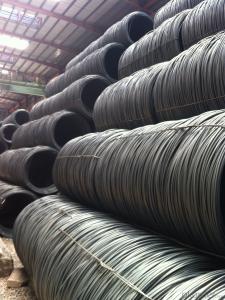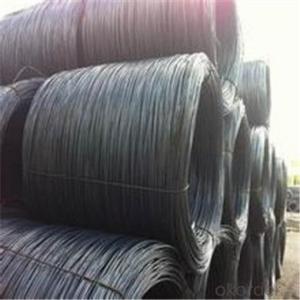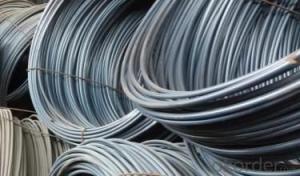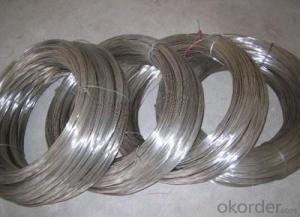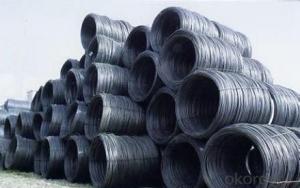Steel wire rod in China hot sale in high carbon
- Loading Port:
- Qingdao
- Payment Terms:
- TT OR LC
- Min Order Qty:
- 100 m.t.
- Supply Capability:
- 15342 m.t./month
OKorder Service Pledge
OKorder Financial Service
You Might Also Like
Specification
Wire rod is used for many different products. Depending upon how it is cold formed and heat treated, wire
is used, for example, to produce not only wire ropes, barbed wire, wire mesh and nails, but also springs,
welded wire mesh and reinforcement wire.
Our Advantage: High quality steel products from 1 class mills in
Reasonable price
Professionalism of the products
On-time delivery
Complete documents and certificates
Sincere service to meet our clients' requirements
Product Description :
Standard | AISI, ASTM, BS, DIN, GB, JIS |
Material/steel grade | Q195-Q235,SAE1006B,SAE1006CR, SAE1008B, SAE1008CR, SAE1010B, SAE1018B, or according to customers requirements |
Wire Gauge | 5.5-12mm |
Coil weight | 1.8-2.1mts |
MOQ | 25MT |
Delivery Time | 15-30 days after receipt of L/C or deposit by T/T |
Packing | In coil and load in container, if large quantity, by bulk vessel; Can be packed as customers' special requirements |
Payment terms | 1).100% irrevocable L/C at sight. 2).30% T/T prepaid and the balance against the copy of B/L. 3).30% T/T prepaid and the balance against L/C |
Application | widely used in machinery parts, manufacturing industry, electronics industry, metal tools and others |
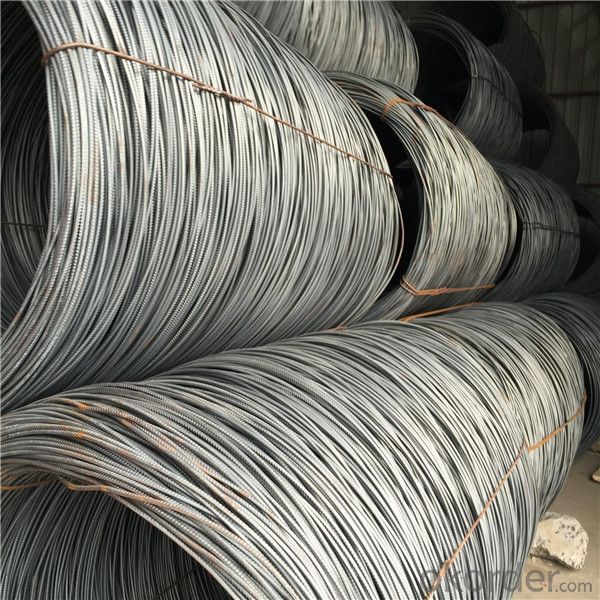


Application :
It generally used in braiding the hose for bathing product and machinery. With it
good flexibility, resistant to high temperature and resistant to corrosion, it
used widely in many industries.
Packing :
Hot-rolled wire rod is held in a unit with at least four steel straps in the
transverse direction and transported and stored without further packaging.
Before
the steel strapping is applied, the wire rod must be sufficiently compressed.
The strapping is fixed in the transverse direction with a single circumferential
strap so that the strapping does not slip and cause the coil to come apart.


Our service:
(1) We cooperate with famous factories with advanced equipment and well trained workers.
(2) We can provide factory price with trading company service.
(3) We continuously work on the improvement of our processes, guaranteeing
consistently high standards of quality to keep none compensation.
(4) We guarantee 24 hours response and 48 hours solution providing service.
(5) We accept small order quantity before formal cooperation.
(6) We deliver the agreed quality at the agreed time, reacting to changes in
customer wishes in a flexible way.
(7) Due to our volume and selling power, we have excellent freight rates with
shipping lines.
(8) We strive to always be fair and honest in our dealings with customers.
(9) We strive to work together with customers to achieve much more than we can
achieve alone.
(10) Through our passion and commitment we aim to be a market leader in all our
key markets. To maintain our position as market leader we must continue to add
value in all that we do.
FAQ:
1.Q: What's your MOQ(minimum order quantity)?
A: One full container, mixed acceptable .
2. Q: What's your packing methods?
A: Packed in bundle or bulk ..
3. Q: How can I buy CNBM products in my country?
A:Please send us an inquiry or email ,we will reply to you if there is distributor in your country
4. Q: Can we visit your factory?
A: Warmly welcome. Once we have your schedule, we will arrange the
professional sales team to follow up your case.
5. Q: How long does it take to get the product if i place an order?
A:With the process of your requirements,we will pack and deliver in 3
-7 days. If it is by sea shipment,it will take 15-45 days depending on different locations
- Q: How is steel wire rod used in the manufacturing of wire for elevator counterweights?
- The production of wire for elevator counterweights relies heavily on steel wire rods. These rods, typically made from carbon or alloy steel, undergo a series of manufacturing processes to meet the specific requirements for elevator counterweights. To begin, the steel wire rods are thoroughly cleaned and descaled to eliminate any impurities or surface contaminants. This guarantees that the resulting wire is of the utmost quality and possesses exceptional resistance to corrosion. Subsequently, the rods are drawn through a succession of dies to reduce their diameter and increase their length. This drawing process imparts the desired tensile strength and flexibility to the wire. Following the drawing process, the wire is typically subjected to annealing, which relieves any internal stresses and enhances its ductility. This involves heating the wire to a precise temperature and gradually cooling it. Annealing not only improves the mechanical properties of the wire but also enhances its resistance to fatigue and wear. Once the wire has been drawn and annealed, it undergoes surface treatment procedures such as coating or galvanizing. Coating the wire with a protective layer, such as zinc or epoxy, serves to prevent corrosion and prolong its lifespan. Galvanizing entails immersing the wire in a bath of molten zinc to create a protective zinc coating, which offers excellent corrosion resistance. Finally, the coated or galvanized wire is further processed to achieve the desired shape and size for elevator counterweights. It can be cut into specific lengths or wound onto spools to facilitate easier handling during the manufacturing process. The wire is then utilized to construct the internal structure of elevator counterweights, which are essential for balancing the elevator car and ensuring its smooth operation. In conclusion, steel wire rods play a crucial role in the production of wire for elevator counterweights. They undergo various processes, including cleaning, drawing, annealing, and surface treatment, to produce high-quality wire with the necessary strength, flexibility, and corrosion resistance. This wire is then utilized to construct the internal structure of elevator counterweights, thus ensuring the safe and efficient operation of elevators.
- Q: How is steel wire rod used in the aerospace industry?
- Steel wire rod is commonly used in the aerospace industry for various applications. It is primarily utilized in the manufacturing of aircraft components like control cables, wire harnesses, and landing gear systems. The high strength and durability of steel wire rod make it suitable for these critical applications, ensuring the safety and reliability of aerospace systems.
- Q: How is steel wire rod used in the manufacturing of wire forms for fishing nets?
- Steel wire rod is a crucial component in the manufacturing of wire forms for fishing nets. The wire rod serves as the raw material from which the wire forms are created. Firstly, the steel wire rod is processed through a series of steps to transform it into a usable wire form. This includes cleaning, annealing, and drawing the wire rod to achieve the desired diameter and tensile strength. These processes ensure that the wire is strong and flexible enough to withstand the tension and stress it will experience when used in fishing nets. Once the wire rod is transformed into wire, it is then used to create the various wire forms required for fishing nets. These wire forms include various components such as hoops, rings, loops, and connectors that are essential for constructing a functional fishing net. The wire forms are created using specialized machinery and techniques, including bending, cutting, and welding the wire according to the specific design requirements. These wire forms are then assembled together to form the net structure. The use of steel wire rod in the manufacturing of wire forms for fishing nets provides numerous advantages. Steel is known for its high strength and durability, making it ideal for withstanding the harsh conditions and constant tension that fishing nets are subjected to. Additionally, steel wire rod is resistant to corrosion, ensuring that the wire forms will have a long lifespan even when exposed to water and other environmental factors. In conclusion, steel wire rod is a vital component in the manufacturing of wire forms for fishing nets. It serves as the raw material from which the wire forms are created, providing the necessary strength, flexibility, and durability required for a functional fishing net.
- Q: How does the hardness of steel wire rod vary with different heat treatment processes?
- The hardness of steel wire rod can vary significantly with different heat treatment processes. Through processes like annealing, the steel wire rod can become softer and more ductile, resulting in lower hardness. On the other hand, processes like quenching and tempering can increase the hardness of the steel wire rod by transforming its microstructure, making it stronger and more resistant to deformation. Therefore, the specific heat treatment process employed determines the hardness of the steel wire rod.
- Q: What are the advantages of using steel wire rod in telecommunication applications?
- The advantages of using steel wire rod in telecommunication applications include its high tensile strength, durability, and resistance to corrosion. Steel wire rod provides a reliable and strong support structure for telecommunication cables, ensuring efficient transmission of signals over long distances. Additionally, steel wire rod is cost-effective, readily available, and easily installable, making it a preferred choice in telecommunication infrastructure.
- Q: What are the main factors affecting the product differentiation of steel wire rod?
- The main factors affecting the product differentiation of steel wire rod include the quality of the raw materials used, the manufacturing process employed, the level of technological innovation, the variety of wire rod sizes and specifications offered, the presence of any specialized or unique features, and the reputation and brand image of the manufacturer. Additionally, factors such as pricing, distribution channels, customer service, and sustainability practices can also play a role in differentiating steel wire rod products in the market.
- Q: How is steel wire rod used in the manufacturing of wire baskets for industrial applications?
- Steel wire rod is a primary material used in the manufacturing of wire baskets for industrial applications. It serves as the base material that is shaped, bent, and welded to create the framework of the basket. The high tensile strength and durability of steel wire rod make it ideal for withstanding heavy loads and rough handling in industrial environments. Additionally, the steel wire rod can be coated or galvanized to enhance corrosion resistance, ensuring longevity and reliable performance of the wire baskets.
- Q: What are the main factors influencing the choice of steel wire rod transportation method?
- The main factors influencing the choice of steel wire rod transportation method include distance, cost, time, and safety. Distance is a significant factor as it determines the mode of transportation that is most suitable. For shorter distances, trucking or rail transport may be the preferable options, while for longer distances, sea or air transport may be more efficient. Cost is another crucial factor as it affects the overall transportation expenses. The cost of each transportation method, including fuel, labor, and maintenance, needs to be considered. Additionally, the cost of any required packaging or handling during transportation should also be taken into account. Time is an important factor, especially for time-sensitive deliveries. Different transportation methods have varying transit times, and the urgency of the delivery may influence the choice of transportation. For example, air transport is generally the fastest option, while sea transport may take longer but could be more cost-effective. Safety is paramount when transporting steel wire rods. The transportation method should ensure the security and integrity of the cargo. Factors such as the susceptibility of steel wire rods to damage, the risk of theft, and the stability of the transportation mode should be considered. For instance, if the steel wire rods are fragile or prone to damage, a transportation method with extra protection, such as containerized shipping, may be preferred. Other factors might also influence the choice of transportation method, such as environmental considerations, infrastructure availability, and the reliability of the chosen transportation service provider. Ultimately, the selection of the steel wire rod transportation method should be based on a careful evaluation of these various factors to ensure the most efficient, cost-effective, and safe transport of the cargo.
- Q: How are steel wire rods used in the production of brush wires?
- Brush wires are created using steel wire rods, which act as the main raw material for high-quality brush bristles. These wire rods, typically made from carbon steel, offer the strength and durability needed for brush wires. To begin the production process, the wire rods are fed into a wire drawing machine where they are pulled through dies to decrease their diameter. This step is repeated until the desired thickness is achieved. The wire is then cut into specific lengths for use as brush bristles. The mechanical properties of steel wire rods make them the preferred choice for brush wires. The carbon steel used in these rods has high tensile strength, enabling the brush bristles to withstand regular use without breaking or bending easily. Moreover, the steel wire rods provide flexibility, which is vital for creating brush bristles that can effectively clean hard-to-reach areas. After the wire drawing process, the brush wires can undergo additional treatments to enhance their performance. This may involve heat treatment to improve hardness and springiness or coating the wires with materials like nylon or brass to add functionality and durability. Once the brush wires are prepared, they can be incorporated into various types of brushes, including toothbrushes, industrial brushes, and paintbrushes. The use of steel wire rods in their production ensures that the resulting brush wires are strong, resilient, and capable of effectively performing their cleaning or scrubbing functions. In conclusion, steel wire rods play a vital role in brush wire production as they offer the necessary strength, durability, and flexibility required for brush bristles. Through a wire drawing process, these wire rods are transformed into brush bristles of the desired thickness. The use of steel wire rods ensures that the final brush wires can endure regular use and effectively clean different surfaces.
- Q: What are the different sizes and dimensions of steel wire rod?
- Steel wire rods are available in a variety of sizes and dimensions to accommodate different industrial and commercial uses. The intended use and manufacturing standards typically determine the sizes and dimensions of steel wire rods. The diameter of steel wire rods can vary from as small as 0.1 millimeters (mm) to as large as 60 mm or more. Generally, the most common sizes in the market range between 5 mm and 20 mm in diameter. However, specialized applications may necessitate wire rods with larger or smaller diameters. The length of steel wire rods can vary significantly depending on the requirements. They are often produced in coils, which can range in length from a few meters to several kilometers. The length of wire rods can be customized to meet the customer's needs or industry standards. Regarding dimensions, steel wire rods are typically manufactured in a round shape. However, they can also be produced in other shapes such as square, rectangular, or hexagonal, depending on the specific application. The most prevalent shape is round because it provides excellent strength and flexibility for various uses. Furthermore, the weight of steel wire rods can vary based on the diameter and length. Usually, the weight is measured in kilograms (kg) or pounds (lb). The weight per unit length is determined by the specific gravity of the steel and the diameter of the wire rod. In conclusion, the sizes and dimensions of steel wire rods are extensive and can be customized to meet specific requirements. Whether it is for construction, automotive, or other industries, steel wire rods are available in a wide range of sizes to accommodate various applications.
Send your message to us
Steel wire rod in China hot sale in high carbon
- Loading Port:
- Qingdao
- Payment Terms:
- TT OR LC
- Min Order Qty:
- 100 m.t.
- Supply Capability:
- 15342 m.t./month
OKorder Service Pledge
OKorder Financial Service
Similar products
Hot products
Hot Searches
Related keywords


